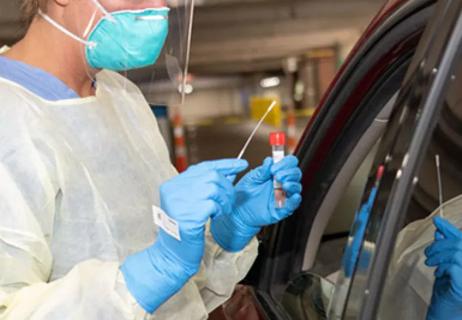Do you know the difference between a molecular test and antigen test for COVID-19?

With COVID-19 cases again surging across the country and more people getting tested, there’s a need for understanding the different types of tests available since not everyone receives the same kind of tests.
Advertisement
Cleveland Clinic is a non-profit academic medical center. Advertising on our site helps support our mission. We do not endorse non-Cleveland Clinic products or services. Policy
Understanding the different types of tests that are being used to tests for COVID-19 is a key part of understanding your results: how the test works, the chance of a false negative or false positive and your own symptomatic timeline.
To better grasp how these tests work and their main differences, we spoke with pathologist Brian Rubin, MD, PhD.
There are currently two primary types of COVID-19 tests being used to test patients for COVID-19: molecular tests (also known as nucleic acid, RNA or PCR tests) and rapid antigen tests.
The third type of testing looks for antibodies created to combat the virus. While sometimes used, these tests can only identify if you had the virus in the past. Additionally, antibody tests still face issues related to questions of accuracy, varying antibody levels from patient to patient and whether or not results can actually be useful for general patients.
Molecular COVID-19 tests, according to Dr. Rubin, are “more sensitive and specific” than antigen tests, making them more accurate than antigen tests. They’re frequently performed by testing a swab of a specimen taken from the patient’s nose.
“What molecular tests do is it looks for and detects the RNA (or nucleic acid) component of the virus,” says Dr. Rubin. “That’s opposed to the antigen tests which are looking for the proteins from the virus.”
Advertisement
You’ve probably heard about PCR tests, which are the most commonly used COVID-19 tests and a subset of molecular tests, he adds. But what, exactly, is a PCR test?
First, “PCR” stands for “polymerase chain reaction” which is a way of amplifying the nucleic acids in your sample. According to the FDA, the polymerase chain reaction converts any virus RNA in your sample into DNA and “amplifies” it by making millions of copies of the DNA which the molecular test can then detect.
Because a PCR test can run multiple cycles of this amplification, it’s capable of detecting the virus even if there’s a low level of the viral RNA in your sample.
“There’s not a lot of RNA in the specimen taken from your swab that’s being tested,” Dr. Rubin says, “so the amplification allows labs to detect the virus more easily and makes it more sensitive.”
The primary type of PCR tests used during the pandemic to this point are RT-PCR tests. These tests target a very specific RNA. In this case, the RT-PCR tests look for the COVID-19 RNA.
Since the beginning of the pandemic, though, experts have developed the Multiplex Assay PCR test, a more efficient PCR test capable of testing for multiple viruses –COVID-19, influenza A, influenza B and respiratory syncytial virus (RSV) – simultaneously.
Starting in the winter of 2021-2022, the CDC will begin phasing out the older RT-PCR tests in favor of the Multiplex Assay PCR test. Besides being more efficient, it should help clarify what virus patients have since symptoms of these viruses can be very similar.
The molecular COVID-19 test is more accurate than the antigen test, according to Dr. Rubin. The trade-off is that while results from most molecular tests come back in good time, around 24 hours, some may take longer depending on if they’re sent to an outside laboratory and how backed-up that lab is with other tests.
That’s the advantage of antigen tests: they can give results in as little as 15 minutes, don’t require being sent to a lab for those results and have proven to be much cheaper to produce. They can also detect the virus in patients who are still highly infectious which can help for isolation and quarantine purposes.
The problem, though, is that they’re not as sensitive as the molecular tests, so a patient is more likely to receive falsely negative results with antigen tests. False-negative results are more likely to occur if somebody gets tested a week or longer after symptoms start. At that point, the amount of antigen is typically low and could go undetected even though the patient has COVID-19.
Advertisement
And as more of these types of tests are used as point-of-care tests, where everything can be taken care of where you’re receiving care instead of being sent to a lab, they also require a better understanding of the results, other contextual information (like the average positivity rate in a patient’s geographical area) and the potential problems a false test result can bring.
So, for now, the PCR tests remain the gold standard of COVID-19 tests.
Advertisement
Learn more about our editorial process.
Advertisement

Here's what to know and keep an eye out for

You have all the symptoms, but here’s why you still might not get tested

The short answer: It’s complicated, but the basic care precautions still prevail, like washing your hands and isolating if you’re sick

They can feel like a typical headache or a migraine headache, but the pain can last for weeks to months

Any large social gathering — from a family birthday party to an indoor music concert — has the potential to spread serious infection

It’s important to connect with a healthcare provider, get quality sleep and balance your activities with your energy levels

Symptoms can overlap and be hard to distinguish, but there are some telltale differences

Just like the flu, COVID-19 will continue to evolve every year

Type 2 diabetes isn’t inevitable with these dietary changes

Applying a hot or cold compress can help with pain